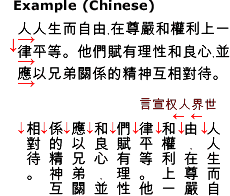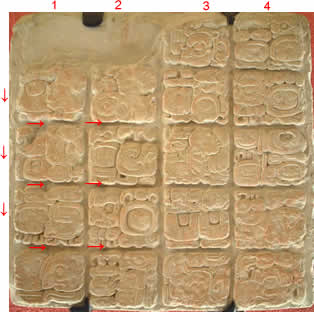99 Perfect Names and Attributes of Allah
It is not possible to perfectly translate the names and attributes of Allah from their original Arabic into English. However, here are some fairly close explanations.
Please note: Many Muslims take on all the names below (except for # 1) without the 'Al' prefix. For example, Rahman, Rahim, Malik, etc. are common names of male Muslims.
1. Allah: He who has the Godhood which is the power to create the entities.
2. Ar-Rahman: The One who has plenty of mercy for the believers and the blasphemers in this world and especially for the believers in the hereafter.
3. Ar-Rahim: The One who has plenty of mercy for the believers.
4. Al-Malik: The One with the complete Dominion, the One Whose Dominion is clear from imperfection.
5. Al-Quddus: The One who is pure from any imperfection and clear from children and adversaries.
6. As-Salam: The One who is free from every imperfection.
7. Al-Mu'min: The One who witnessed for Himself that no one is God but Him. And He witnessed for His believers that they are truthful in their belief that no one is God but Him.
8. Al-Muhaymin: The One who witnesses the saying and deeds of His creatures.
9. Al-^Aziz: The Defeater who is not defeated.
10. Al-Jabbar: The One that nothing happens in His Dominion except that which He willed.
11. Al-Mutakabbir: The One who is clear from the attributes of the creatures and from resembling them.
12. Al-Khaliq: The One who brings everything from non-existence to existence.
13. Al-Bari': The Creator who has the Power to turn the entities.
14. Al-Musawwir: The One who forms His creatures in different pictures.
15. Al-Ghaffar: The One who forgives the sins of His slaves time and time again.
16. Al-Qahhar: The Subduer who has the perfect Power and is not unable over anything.
17. Al-Wahhab: The One who is Generous in giving plenty without any return.
18. Ar-Razzaq: The One who gives everything that benefits whether Halal or Haram.
19. Al-Fattah: The One who opens for His slaves the closed worldy and religious matters.
20. Al-^Alim: The Knowledgeable; The One nothing is absent from His knowledge.
21. Al-Qabid and 22. Al-Basit: The One who constricts the sustenance by His wisdom and expands and widens it with His Generosity and Mercy.
23. Al-Khafid and 24. Ar-Rafi^: The One who lowers whoever He willed by His Destruction and raises whoever He willed by His Endowment.
25. Al-Mu^iz and 26. Al-Muthil: He gives esteem to whoever He willed, hence there is no one to degrade Him; And He degrades whoever He willed, hence there is no one to give Him esteem.
27. As-Sami^: The One who Hears all things that are heard by His Eternal Hearing without an ear, instrument or organ.
28. Al-Basir: The One who Sees all things that are seen by His Eternal Seeing without a pupil or any other instrument.
29. Al-Hakam: He is the Ruler and His judgment is His Word.
30. Al-^Adl: The One who is entitled to do what He does.
31. Al-Latif: The One who is kind to His slaves and endows upon them.
32. Al-Khabir: The One who knows the truth of things.
33. Al-Halim: The One who delays the punishment for those who deserve it and then He might forgive them.
34. Al-^Azim: The One deserving the attributes of Exaltment, Glory, Extolement,and Purity from all imperfection.
35. Al-Ghafur: The One who forgives a lot.
36. Ash-Shakur: The One who gives a lot of reward for a little obedience.
37. Al-^Aliyy: The One who is clear from the attributes of the creatures.
38. Al-Kabir: The One who is greater than everything in status.
39. Al-Hafiz: The One who protects whatever and whoever He willed to protect.
40. Al-Muqit: The One who has the Power.
41. Al-Hasib: The One who gives the satisfaction.
42. Aj-Jalil: The One who is attributed with greatness of Power and Glory of status.
43. Al-Karim: The One who is clear from abjectness.
44. Ar-Raqib: The One that nothing is absent from Him. Hence it's meaning is related to the attribute of Knowledge.
45. Al-Mujib: The One who answers the one in need if he asks Him and rescues the yearner if he calls upon Him.
46. Al-Wasi^: The Knowledgeable.
47. Al-Hakim: The One who is correct in His doings.
48. Al-Wadud: The One who loves His believing slaves and His believing slaves love Him. His love to His slaves is His Will to be merciful to them and praise them:Hence it's meaning is related to the attributes of the Will and Kalam (His attribute with which He orders and forbids and spoke to Muhammad and Mu sa -peace be upon them- . It is not a sound nor a language nor a letter).
49. Al-Majid: The One who is with perfect Power, High Status, Compassion, Generosity and Kindness.
50. Al-Ba^ith: The One who resurrects His slaves after death for reward and/or punishment.
51. Ash-Shahid: The One who nothing is absent from Him.
52. Al-Haqq: The One who truly exists.
53. Al-Wakil: The One who gives the satisfaction and is relied upon.
54. Al-Qawiyy: The One with the complete Power.
55. Al-Matin: The One with extreme Power which is un-interrupted and He does not get tired.
56. Al-Waliyy: The Supporter.
57. Al-Hamid: The praised One who deserves to be praised.
58. Al-Muhsi: The One who the count of things are known to him.
59. Al-Mubdi': The One who started the human being. That is, He created him.
60. Al-Mu^id: The One who brings back the creatures after death.
61. Al-Muhyi: The One who took out a living human from semen that does not have a soul. He gives life by giving the souls back to the worn out bodies on the resurrection day and He makes the hearts alive by the light of knowledge.
62. Al-Mumit: The One who renders the living dead.
63. Al-Hayy: The One attributed with a life that is unlike our life and is not that of a combination of soul, flesh or blood.
64. Al-Qayyum: The One who remains and does not end.
65. Al-Wajid: The Rich who is never poor. Al-Wajd is Richness.
66. Al-Majid: The One who is Majid.
67. Al-Wahid: The One without a partner.
68. As-Samad: The Master who is relied upon in matters and reverted to in ones needs.
69. Al-Qadir: The One attributed with Power.
70. Al-Muqtadir: The One with the perfect Power that nothing is withheld from Him.
71. Al-Muqaddim and 72. Al-Mu'akhkhir: The One who puts things in their right places. He makes ahead what He wills and delays what He wills.
73. Al-'Awwal: The One whose Existence is without a beginning.
74. Al-'Akhir: The One whose Existence is without an end.
75. Az-Zahir 76. Al-Batin: The One that nothing is above Him and nothing is underneath Him, hence He exists without a place. He, The Exalted, His Existence is obvious by proofs and He is clear from the delusions of attributes of bodies.
77. Al-Wali: The One who owns things and manages them.
78. Al-Muta^ali: The One who is clear from the attributes of the creation.
79. Al-Barr: The One who is kind to His creatures, who covered them with His sustenance and specified however He willed among them by His support, protection, and special mercy.
80. At-Tawwab: The One who grants repentance to whoever He willed among His creatures and accepts his repentance.
81. Al-Muntaqim: The One who victoriously prevails over His enemies and punishes them for their sins. It may mean the One who destroys them.
82. Al-^Afuww: The One with wide forgiveness.
83. Ar-Ra'uf: The One with extreme Mercy. The Mercy of Allah is His will to endow upon whoever He willed among His creatures.
84. Malik Al-Mulk: The One who controls the Dominion and gives dominion to whoever He willed.
85. Thul-Jalal wal-Ikram: The One who deserves to be Exalted and not denied.
86. Al-Muqsit: The One who is Just in His judgment.
87. Aj-Jami^: The One who gathers the creatures on a day that there is no doubt about, that is the Day of
Judgment.
88. Al-Ghaniyy: The One who does not need the creation.
89. Al-Mughni: The One who satisfies the necessities of the creatures.
90. Al-Mani^: The Supporter who protects and gives victory to His pious believers. Al-Mu'tiy The Withholder
91. Ad-Darr and 92. An-Nafi^: The One who makes harm reach to whoever He willed and benefit to whoever He willed.
93. An-Nur: The One who guides.
94. Al-Hadi: The One whom with His Guidance His belivers were guided, and with His Guidance the living: beings have been guided to what is beneficial for them and protected from what is harmful to them.
95. Al-Badi^: The One who created the creation and formed it without any preceding example.
96. Al-Baqi: The One that the state of non-existence is impossible for Him.
97. Al-Warith: The One whose Existence remains.
98. Ar-Rashid: The One who guides.
99. As-Sabur: The One who does not quickly punish the sinners.
 Left to right, horizontal
Left to right, horizontal 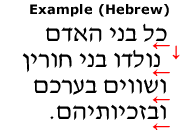 Right to left, horizontal
Right to left, horizontal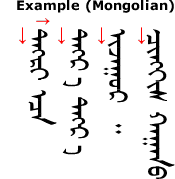 Left to right, vertical
Left to right, vertical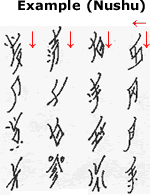 Right to left, vertical
Right to left, vertical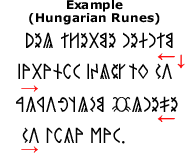 Boustrophedon
Boustrophedon
